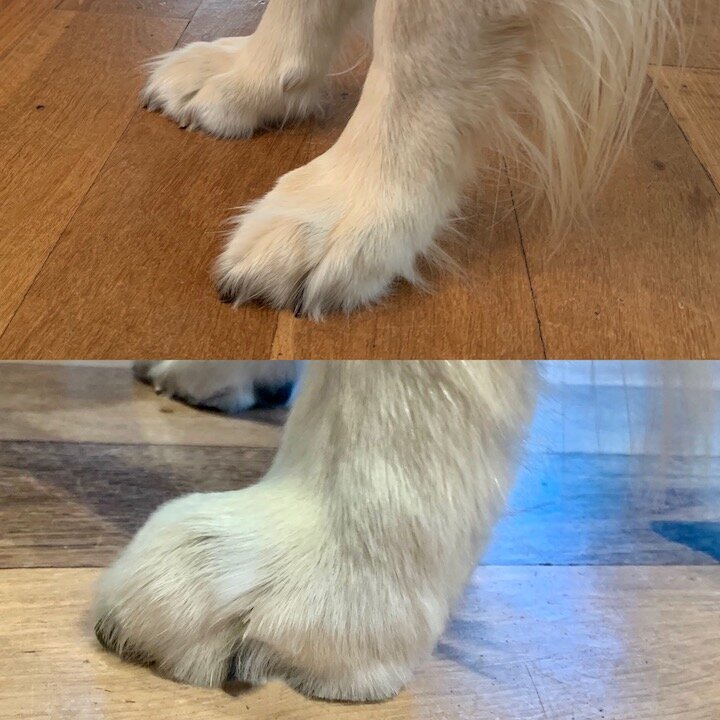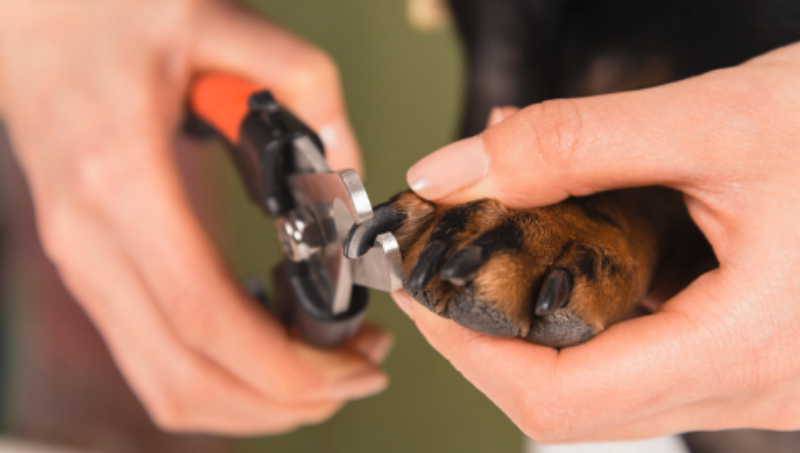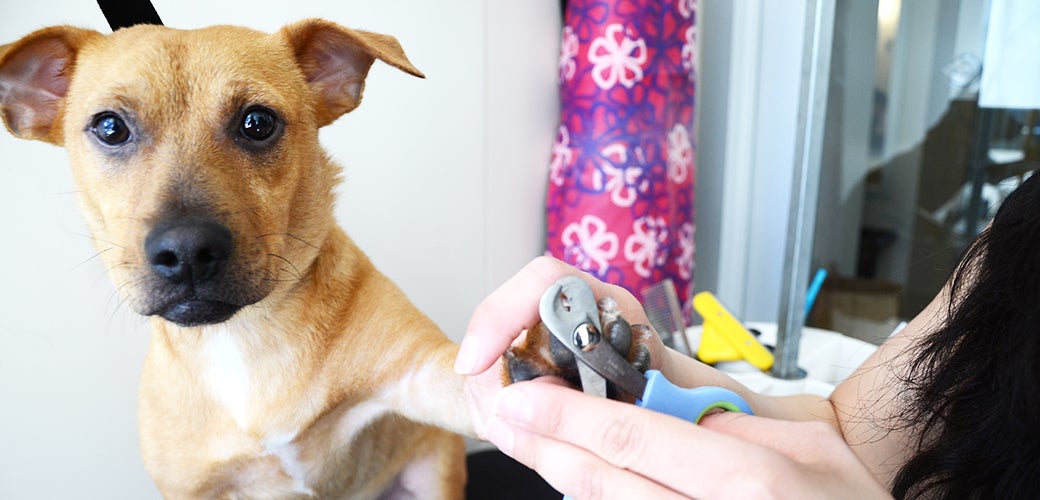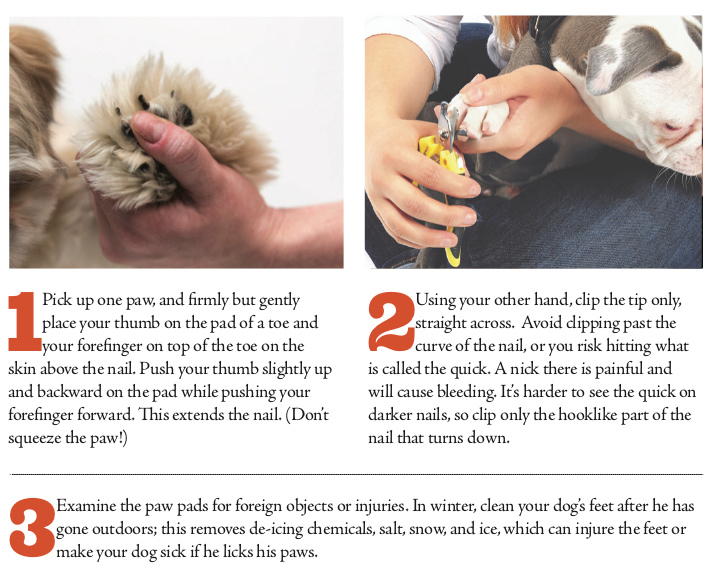Cut your dog’s nails every 4-6 weeks to maintain their health and prevent painful issues. Keeping your dog’s nails at a proper length is essential for their overall well-being.
Regular nail trimming helps prevent discomfort, pain, and potential injuries. Overgrown nails can cause difficulty walking, lead to joint problems, and even break, causing bleeding and infection. Maintaining a consistent nail care routine is crucial. However, the frequency of nail trimming may vary depending on your dog’s lifestyle and breed.
While some dogs may require more frequent nail trims, others may naturally wear down their nails through exercise. Regularly inspect your dog’s nails and trim them when they become too long to ensure their comfort and health.

Credit: canineworks.com.au
Understanding The Importance Of Regular Nail Trimming
Dogs’ nails play a crucial role in their overall health and well-being. Just like humans, dogs’ nails grow continuously, and if left unattended, they can become long and sharp, leading to a variety of problems. Regular nail trimming is an essential part of pet care, as it helps maintain your furry friend’s mobility, comfort, and overall health.
Why Regular Nail Trimming Is Essential For Dogs
Regular nail trimming for dogs is vital for several reasons:
- Comfortable Walking: Dogs with long nails find walking uncomfortable and challenging. Overgrown nails can push against their pads, causing pain and even altering their gait. Trimming your dog’s nails regularly ensures they can walk and run comfortably.
- Prevention of Injuries: Long nails are more prone to breakage or splitting, which can lead to bleeding and infections. By keeping your dog’s nails well-trimmed, you reduce the risk of such injuries, keeping them safe and healthy.
- Prevention of Orthopedic Issues: When a dog’s nails are too long, it can alter the alignment of their paws and affect their skeletal structure. This misalignment can lead to discomfort, joint problems, and even difficulty in standing or walking properly.
- Prevention of Paw Deformities: Over time, if nails are left untrimmed, they can grow excessively and even curl inwards. This condition is not only painful for your dog but can also result in deformities of the paw and potentially serious health complications.
Signs That Indicate It’s Time To Trim Your Dog’s Nails
Not sure if it’s time to trim your dog’s nails? Here are some signs to look out for:
- Clicking Sounds: If you hear your dog’s nails clicking on the floor while they walk, it’s a clear indication that their nails are too long and need trimming.
- Visible Length: Take a close look at your dog’s nails. If you can visibly see them extending past the pads, it’s time for a trim.
- Discomfort During Walking: If your dog appears to be limping, favoring certain paws, or acting hesitant while walking, it could be due to excessive nail length causing discomfort.
- Scratching: If your dog scratches surfaces more often than usual, it could be a sign that their nails are too long and need attention.
Consequences Of Neglecting Dog Nail Trimming
Neglecting regular nail trimming for your dog can have various adverse effects:
- Pain and Discomfort: Long nails can cause pain and discomfort to your dog, hindering their overall quality of life.
- Infections: Overgrown nails are more prone to breakage and splitting, leaving your dog vulnerable to infections.
- Mobility Issues: Over time, untreated long nails can impact your dog’s mobility, making it difficult for them to walk, run, or perform regular activities.
- Behavioral Changes: Dogs with overgrown nails may exhibit behavioral changes such as irritability, anxiety, or aggression due to the pain and discomfort they experience.
- Paw Deformities: If left untrimmed for extended periods, nails can curl inwards, leading to paw deformities and potential long-term health issues.
Determining The Optimal Frequency For Dog Nail Trimming
Regular nail trimming is an important aspect of dog grooming that contributes to their overall health and well-being. But how often should you cut your dog’s nails? Determining the optimal frequency can vary depending on several factors.
Factors That Influence How Often Dogs Should Have Their Nails Trimmed
When it comes to determining how often your dog’s nails should be trimmed, it’s crucial to consider various factors:
- Activity Level: Dogs with an active lifestyle, such as those that frequently participate in agility training or play on hard surfaces, naturally wear down their nails more, requiring less frequent trimming.
- Nail Growth Rate: While individual dogs may vary, certain breeds are prone to faster nail growth, necessitating more frequent nail trims.
- Nail Shape: Different breeds have varying nail shapes and structures. Dogs with dewclaws or curved or long nails may require more frequent trimming to prevent discomfort.
- Age: Puppies often have softer nails that wear down easily, requiring less frequent trims. As dogs age, their nails may become brittle and grow more slowly, adjusting the trimming frequency accordingly.
- Nail Care Routine: Consistent grooming habits, including regular walks on pavement or the use of scratching posts, can naturally maintain shorter nails and decrease the need for frequent trims.
Differentiate Between Dog Breeds And Their Nail Trimming Needs
Understanding the specific nail trimming needs of different dog breeds can help you establish an appropriate frequency. Here are some general guidelines:
| Breed | Recommended Frequency |
|---|---|
| Small Breeds (e.g., Chihuahuas, Dachshunds) | Every 2-3 weeks |
| Medium Breeds (e.g., Bulldogs, Beagles) | Every 3-4 weeks |
| Large Breeds (e.g., Labradors, Golden Retrievers) | Every 4-6 weeks |
| Giant Breeds (e.g., Great Danes, Saint Bernards) | Every 6-8 weeks |
Remember, these are general recommendations, and individual dogs may have unique needs. Monitoring your dog’s nail length and adjusting the frequency accordingly is essential.
Varying Nail Growth Rates In Dogs And Frequency Adjustments
It’s important to observe your dog’s nail growth rate and make necessary adjustments to the trimming frequency. Some dogs may require more frequent trims due to rapid growth, while others may need less frequent trims due to slower growth.
- Monitor your dog’s nails regularly. If they start to touch the ground or make clicking sounds while walking, it’s a sign that they require trimming.
- Trim the nails gradually. By removing a little at a time, you can prevent cutting into the quick, which can cause bleeding and pain.
- Be cautious with dark-colored nails. With these nails, it’s challenging to visualize the quick, making it crucial to trim a small amount at a time to avoid any discomfort.
- If you’re uncertain or uncomfortable trimming your dog’s nails, consult a professional groomer or veterinarian who can help ensure proper nail care.
By considering these factors, differentiating between breeds, and adjusting the frequency based on individual nail growth rates, you can determine the optimal frequency for your dog’s nail trims. Regular nail maintenance is essential for your dog’s health, so always prioritize their comfort and well-being when it comes to grooming their nails.
Tips And Techniques For Safe And Stress-free Dog Nail Trimming
Keeping your dog’s nails at an appropriate length is an essential part of their overall grooming routine. However, many dog owners find the task of nail trimming to be daunting and stressful. With the right techniques and tools, you can make the process safe and stress-free for both you and your furry friend. In this blog post, we will provide you with tips and step-by-step guidance on proper dog nail trimming, as well as alternative methods for maintaining shorter nails.
Choosing The Right Nail Trimming Tools For Your Dog
When it comes to trimming your dog’s nails, having the right tools is crucial for a successful and comfortable experience. Below are some factors to consider while choosing the nail trimming tools for your canine companion:
- Nail clippers: There are two main types of nail clippers available: guillotine-style clippers and scissor-style clippers. The guillotine-style clippers have a round opening through which you’ll insert your dog’s nail, while the scissor-style clippers operate more like human nail clippers. Choose the one that you feel most comfortable using.
- Nail grinder: A nail grinder is an alternative to clippers and can be useful for dogs with thick nails. It is an electric tool that grinds down the nail gradually, resulting in a smoother finish. Nail grinders can be particularly helpful for dogs who are sensitive to the pressure applied by clippers.
- Styptic powder: Accidents happen, and if you accidentally cut your dog’s nail too short, it can lead to bleeding. Having styptic powder on hand can help stop the bleeding quickly. This powder is formulated to constrict blood vessels and promote clotting.
Step-by-step Guide For Proper Dog Nail Trimming
Proper technique is essential to ensure a safe and stress-free nail trimming session for your dog. Follow the step-by-step guide below to trim your dog’s nails efficiently:
- Prepare the environment: Find a quiet and well-lit area where you and your dog can be comfortable during the nail trimming session. Make sure you have all your tools and supplies within reach.
- Introduce the tools: Familiarize your dog with the nail clippers or grinder by allowing them to sniff and inspect the tools. This will help them feel more at ease before you begin.
- Handle their paws: Gently hold your dog’s paw and apply slight pressure to extend the nails. Be careful not to squeeze or apply too much pressure, as this may cause discomfort.
- Identify the quick: The quick is the sensitive, pink area within the nail that contains blood vessels and nerves. It’s important to avoid cutting into the quick, as it can cause pain and bleeding. Cut a small amount of the nail at a time, avoiding the quick.
- Use a steady hand: Hold the clippers or grinder with a firm and steady grip. If you’re using clippers, position them perpendicular to the nail for a clean cut. If using a grinder, gently touch it to the nail to remove small amounts gradually.
- Monitor progress and reward: After each nail trim, take a look at your dog’s nails to assess the length. Reward your pup with treats and praise to associate positive experiences with nail trimming.
- Stop if needed: If you or your dog become too stressed or anxious during the process, it’s okay to take a break or seek professional help from a groomer or veterinarian.
Alternative Methods For Maintaining Shorter Dog Nails
If you find that traditional nail trimming techniques are causing stress for you or your dog, there are alternative methods that can help maintain shorter nails:
- Regular walks on hard surfaces: Taking your dog for walks on concrete or asphalt can naturally wear down their nails over time. This can be a great option for dogs who are resistant to nail trimming.
- Nail filing: Similar to human nail filing, you can use a nail file or emery board to gradually shorten your dog’s nails. This method works best for dogs with smaller or more fragile nails.
- Professional grooming services: If you’re unsure about trimming your dog’s nails yourself or if your dog requires more advanced grooming techniques, consider taking them to a professional groomer. They have the expertise to handle nail trimming safely and efficiently.
Following these tips and techniques, you can keep your dog’s nails at an appropriate length while minimizing stress and discomfort. Remember, patience and positive reinforcement are key to establishing a successful nail trimming routine with your beloved pet.

Credit: www.vetcarepethospital.ca

Credit: www.aspca.org
Frequently Asked Questions For How Often Should I Cut My Dog’s Nails
How Often Do Indoor Dogs Need Their Nails Trimmed?
Indoor dogs typically need their nails trimmed every 1-2 months to maintain their paw health and prevent discomfort or injury. Regular trimming ensures their nails don’t get too long, causing difficulties in walking or scratching.
How Do I Know If My Dogs Nails Are Too Long?
If your dog’s nails touch the ground when they walk, or you hear clicking sounds, their nails are likely too long. Check if the nails curve down or cause discomfort. Regularly trim the nails or consult a veterinarian for proper nail care.
What Happens If You Don’t Trim Your Dog’s Nails?
Not trimming your dog’s nails can lead to discomfort, pain, and potential health issues. Long nails can cause problems with walking and lead to joint issues. They can also break or get caught, causing bleeding and infections. Regular nail trims are essential for your dog’s well-being.
How Long Can A Dog Go Without Cutting Nails?
A dog should not go more than 2-4 weeks without getting its nails trimmed. Long nails can cause discomfort and affect its mobility. Regular nail maintenance is important for a dog’s health and well-being.
Conclusion
Regular nail trimming is crucial for the health and comfort of your furry friend. By understanding their specific needs and taking into account factors such as breed, activity level, and nail growth rate, you can determine how often you should cut your dog’s nails.
Whether you choose to do it yourself or seek professional help, keeping their nails at the proper length will ensure their overall well-being. Remember, a little bit of effort can go a long way in preventing any potential nail-related problems for your beloved canine companion.



